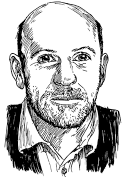In contemporary art’s cosmos, Peter Doig has for some years been a star both lucent and unique. Doig is a figurative painter whose lush dreamscapes at once evoke his medium’s past and suggest the feel of photos and films, and his big canvases hang in famed museums and are prized by collectors worldwide. But on the Caribbean island of Trinidad, where he lives, Doig is likely known less for his work than for the space where he makes it. In 2003, he founded StudioFilmClub with the Trinidadian artist Che Lovelace. In an airy old rum factory with a digital projector on one wall, a large screen on another, and a homey bar stocked with coconut water and local Stag beer, he hosts free screenings. Each Thursday night, FilmClub’s patrons thrill to independent and art-house films ranging from Killer of Sheep and Klute to—on the night of my first visit a couple years ago—Nagisa Oshima’s 1976 classic of sensual obsession, In the Realm of the Senses.
Born in Scotland in 1959, Doig had a peripatetic life from the start. When he was little, his parents moved to Trinidad, where his father worked for a shipping company that later transferred them to Canada. In 1979, Doig moved to London to attend art school, where he began a course in set design before switching to painting. He spent part of the ’80s in Montreal, working as a dresser for the opera and making sets, before returning to London and, painting snowy memories of his Canadian days, launching the high-profile career that saw him nominated for the Turner Prize in 1994, and gaining a repute equal to that of any living peer. In 2002, Doig returned to Trinidad with his family and has lived there since. Traveling often to far-flung exhibitions and teaching gigs, he returns home, invariably, with fresh Blu-ray discs for screenings he blazons with impromptu film posters that he paints, on Thursday afternoons, and hangs still wet near his studio door.
On the hot October morning when I dropped by Doig’s place, on the dusty outskirts of Trinidad’s capital, Port of Spain, I found him dragging chairs toward a back wall already lined with empty cases of Stag. That week, he’d hosted two screenings as part of the island’s burgeoning yearly film festival: Senna, Asif Kapadia’s remarkable documentary on the eerily well-documented life and crash of the race driver Ayrton Senna (“Did you see how many guys showed up in F1 shirts?” Doig said excitedly), and Kapadia’s rather different first feature, The Warrior. On the radio that morning, we’d learned that it was the birthday of ’70s calypso legend the Mighty Shadow;...
You have reached your article limit
Sign up for a digital subscription and continue reading all new issues, plus our entire archives, for just $1.50/month.
Already a subscriber? Sign in





